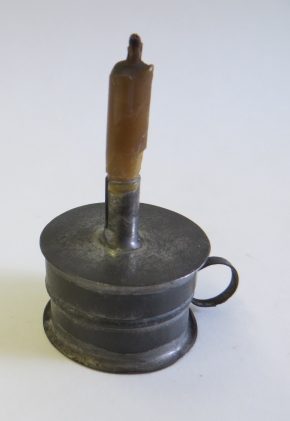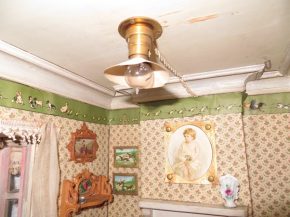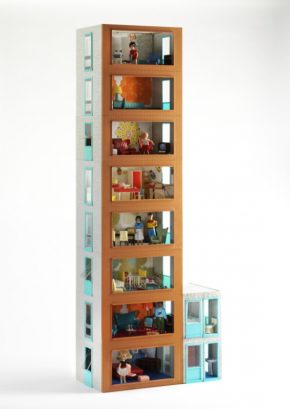
Lighting is vital for creating a particular atmosphere at home. Do you want it to be rich or minimal, soft and warm or stark and clinical? Developing our approach to lighting our dolls’ houses, we had to balance safety and protection for these treasured historic museum objects, with finding the right interpretive light effects to bring each house’s story and detail to life.
Many of the dolls’ houses in the Small Stories exhibition were wired for lighting by their previous owners. Amy Miles’ house was made in the 1890s, soon after most real homes began to use electricity. Each room is fully wired with electric lights complete with miniature working bulbs and tiny lampshades. But, as with a real house, using hundred year-old wiring is neither advisable or safe!

The other issue is light damage. Over time, high light levels can fade paper and textiles – that’s why the Museum’s lighting is typically quite low. In our permanent displays, the lights are on all day so they have to be very dim. This is good for the protection of the precious historic objects, but not good news for visitors who want to see in.
For the new Small Stories exhibition we have been working with colleagues in Furniture and Science Conservation and a specialist doll’s house lighting expert to safely light our dolls’ houses. Visitors will illuminate them through push buttons and at the same time activate the audio of the house’s characters. Because the lights will only be on for short amounts of time, they can be a bit brighter. Hopefully we’ll all be able to see much more of the exquisite detail of each room.

Safe LED lights are being threaded into each room through existing holes, windows or hinges. The wires are so thin they can fit through the tiniest cracks. Other houses will have a framework sitting in front, with lights shining into the house. Since every house is set at a particular time of night or day, the lighting will be subtly different for each one.


Lighting for Photography

Whiteladies house is set late on a summer’s afternoon with low sunlight pouring in through the large picture windows. When we shot these photographs, we tried to capture this atmosphere in the V&A Photography Studio.


Creating photographs of Jennys home – a 1960s tower block – was also a challenge. Each modular unit for the tower block is small, so strong studio lights had to be carefully positioned to enable each of the 10 rooms to appear light-filled and lived in.



The pics are very nice in this blog and kids really like these type of dolls house
I really enjoyed learning about the dolls’ houses in this post. The details and history are amazing!